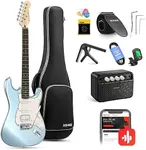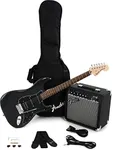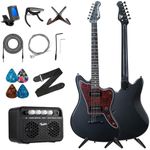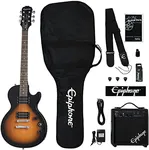Buying Guide for the Best Beginner Electric Guitars
Choosing your first electric guitar is an exciting step in your musical journey. The right guitar can make learning easier and more enjoyable, so it's important to understand what features matter most for beginners. Focus on comfort, playability, and versatility rather than advanced features you might not need yet. By understanding the key specifications, you can find a guitar that matches your musical interests and feels good in your hands.Body TypeThe body type of an electric guitar refers to its shape and construction, which affects both comfort and sound. There are three main types: solid body, semi-hollow, and hollow body. Solid body guitars are the most common for beginners because they are durable, less prone to feedback, and suitable for a wide range of music styles. Semi-hollow and hollow body guitars have a warmer tone but can be more prone to feedback and are often used for jazz or blues. For most beginners, a solid body guitar is a safe and versatile choice.
Neck Profile and Scale LengthThe neck profile describes the shape and thickness of the guitar neck, while the scale length is the distance between the nut and the bridge. A thinner neck profile is generally easier for beginners, especially those with smaller hands, as it makes it easier to reach around and press the strings. Scale length affects string tension and playability; shorter scale lengths make the strings feel looser and easier to press, which can be helpful for new players. Try holding different guitars to see what feels most comfortable for your hand size and playing style.
Pickup ConfigurationPickups are the components that capture the string vibrations and turn them into sound. The most common types are single-coil and humbucker pickups. Single-coils have a bright, clear sound, while humbuckers are thicker and reduce unwanted noise. Some guitars have a mix of both. For beginners, a guitar with a versatile pickup configuration (like one with both single-coil and humbucker pickups) allows you to experiment with different sounds and find what you like best.
Weight and SizeThe weight and size of a guitar can greatly affect your comfort, especially during long practice sessions. Lighter guitars are easier to hold and play, particularly for younger players or those with smaller frames. Heavier guitars can be tiring to play standing up for long periods. When choosing, pick up the guitar and see how it feels; you should be able to hold and play it comfortably without strain.
Fretboard MaterialThe fretboard is the part of the neck where you press the strings. Common materials include rosewood, maple, and laurel. While the differences in sound are subtle, the feel can vary. Some players prefer the smoothness of rosewood, while others like the slickness of maple. As a beginner, focus on what feels comfortable under your fingers, as this will encourage you to practice more.
Tuning Stability and HardwareTuning stability refers to how well the guitar stays in tune while you play. Good quality tuners and a well-made bridge help keep your guitar in tune, which is important for beginners who are still learning to tune by ear. Look for guitars with solid, easy-to-use tuning pegs and a bridge that feels sturdy. This will save you frustration and help you focus on learning.



















